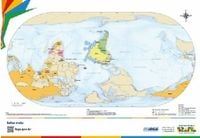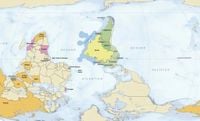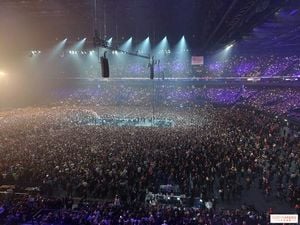The Instituto Brasileiro de Geografia e Estatística (IBGE) has recently stirred up discussions by unveiling a new world map that positions Brazil at the center, literally flipping the traditional geographic representation on its head. This new map, which was launched on May 7, 2025, features the Southern Hemisphere at the top and emphasizes Brazil’s prominent role in international forums, including BRICS and Mercosur.
According to IBGE President Márcio Pochmann, this innovative approach aims to highlight Brazil's geopolitical significance. In a post on social media, he stated, "The IBGE launched a new world map with Brazil in the center, containing the South at the top of the map, also identified as an inverted map." This shift is not merely a cosmetic change; it symbolizes Brazil's expected leadership in addressing global challenges.
The map prominently highlights member countries of BRICS and Mercosur, as well as regions of environmental and cultural importance, such as the Amazon biome. Notable Brazilian cities that will host significant international events are also marked, including Belém, which is set to host COP 30 in November 2025, Rio de Janeiro, designated as the capital of BRICS, and Ceará, which will hold the Triple International Forum of Southern Global Governance.
Belém's role as the host city for COP 30, a crucial United Nations climate change conference, underscores Brazil's growing influence in global environmental discussions. The conference is expected to bring together world leaders and environmentalists to discuss the implementation of the Paris Agreement, which aims to limit global temperature rise to below 2 degrees Celsius by the end of the century. Given Brazil's vast Amazon rainforest, the country is viewed as a key player in the international climate agenda.
However, the launch of the new map comes amid internal turmoil within the IBGE, where Pochmann has faced accusations of authoritarianism and a centralizing management style. In January 2025, over 600 employees signed an open letter expressing their concerns about disrespect towards the technical staff and the overall governance of the institute. This internal crisis has raised questions about the credibility of the IBGE, which is responsible for critical national data, including GDP and official inflation rates.
Despite the controversies, President Luiz Inácio Lula da Silva continues to support Pochmann, praising his strategic vision for the institute. Analysts interpret the release of the new map as an institutional repositioning effort amid increasing pressure and internal strife.
The BRICS group, which includes Brazil, Russia, India, China, and South Africa, has recently expanded to include Saudi Arabia, Egypt, the United Arab Emirates, Ethiopia, Indonesia, and Iran. Brazil currently holds the rotating presidency of BRICS, which amplifies its diplomatic responsibilities. The group is expected to address pressing issues, including the economic impacts of trade tensions, particularly with the United States.
The Mercosur trade bloc, in which Brazil plays a pivotal role, is also gaining prominence. Following Bolivia's official admission in 2024 and Venezuela's suspension, Mercosur is looking to strengthen its ties with Europe. Notably, a free trade agreement with the European Union was signed in 2024 after more than two decades of negotiations, although its implementation awaits ratification by member parliaments.
As the COP 30 approaches, there are expectations that it will stimulate new financial commitments for sustainable projects, potentially reaching up to $1 trillion per year for developing countries. This financial influx is seen as essential for advancing global sustainability initiatives.
Moreover, the new map reflects a broader movement towards rethinking how the world is visually represented. By placing Brazil at the center, the IBGE seeks to challenge the Eurocentric perspective that has long dominated cartography. This type of representation aligns with decolonial initiatives, particularly in educational contexts, where it encourages students to explore diverse geopolitical frameworks.
While the map is intended for educational and symbolic purposes, it will not replace the official maps used by the IBGE in technical publications. Instead, it serves to provoke thought and discussion about Brazil's role in the world and how geography shapes our understanding of global dynamics.
Critics of the map argue that it could confuse students, while supporters believe it promotes a necessary decolonization of geographical knowledge, breaking away from the traditional dominance of Europe and the United States. The debate surrounding the map illustrates the complexities of geographical representation and the importance of inclusive narratives in education.
As Brazil prepares to host COP 30, the new world map symbolizes a pivotal moment for the country on the global stage. It encapsulates the aspirations of a nation eager to assert its leadership in international discourse, particularly regarding environmental issues. The map's introduction, while controversial, is a clear indication of Brazil's intent to redefine its image and role in an increasingly interconnected world.





